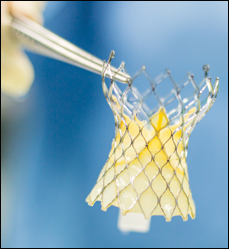TAVR: The Past, Present and Future
Transcatheter aortic valve replacement has markedly improved the lives of many patients with severe aortic stenosis.
Fifteen years ago, Alain Cribier, MD, and colleagues performed the first transcatheter aortic valve replacement in 2002 at Charles Nicolle University Hospital, University of Rouen, France. In the intervening years, TAVR has changed the landscape of CV medicine and brought a new treatment option for patients with aortic stenosis.

“TAVR is ... besides coronary angioplasty, the most important cardiac intervention by catheter,” Bernhard Meier, MD, senior consultant and former chairman of the department of cardiology at the University Hospital of Bern, Switzerland, told Cardiology Today’s Intervention. “TAVR is a brilliant idea, and it will completely replace surgery for isolated degenerative aortic valve replacement.”
An Unmet Need
Before the development of TAVR, options were limited for many patients with severe aortic stenosis. Surgical AVR was considered the best choice, but a large subset of patients were considered too high risk for surgery. Balloon valvuloplasty worked in some patients, but the results generally were not durable.
“There was a substantial number of patients in whom there was an unmet clinical need,” David R. Holmes Jr., MD, MACC, consultant in the division of cardiology, department of medicine, and professor of medicine at Mayo Clinic, and past president of the American College of Cardiology, told Cardiology Today’s Intervention. “Since aortic balloon valvuloplasty did not meet the clinical needs of most patients, there was great interest in the development of catheter-based approaches for replacing the valve. A long period of development led to the introduction of TAVR in 2002 by Cribier, who had initially popularized aortic balloon valvuloplasty.”

As reported by Cribier and colleagues in Circulation in 2002, the first patient was a 57-year-old man with calcified aortic stenosis, cardiogenic shock, subacute leg ischemia and other comorbidities who had failed balloon valvuloplasty and was deemed ineligible for surgery. The valve used, developed by Percutaneous Valve Technologies Inc., and acquired in 2004 by Edwards Lifesciences, was described as consisting of “three bovine pericardial leaflets mounted within a tubular, slotted, stainless steel balloon-expandable stent, 14 mm in length, designed to achieve a diameter of 21 to 23 mm.”
Dramatic Growth
After the concept of TAVR was proved, there was “a dramatic increase in the number of technologies that could be used to improve what had been temporary results from balloon aortic valvuloplasty to longer-term efficacy in a broader group of patients,” Holmes said.

TAVR technologies were approved in 41 other countries before the FDA approved a TAVR system for the first time, a balloon-expandable valve (Sapien, Edwards Lifesciences), in 2011. A self-expanding valve (CoreValve, Medtronic) followed in 2014. Initially, both technologies were approved in patients considered inoperable or at extreme risk for surgery. Their indications were later expanded to include patients at high risk for surgery, and eventually patients at intermediate risk. Both platforms, which have gone through multiple generations, each with improved results, are now being tested in low-risk patients. A third platform (Lotus, Boston Scientific) is under review by the FDA.
Of note, CMS required that for a TAVR procedure to qualify for reimbursement, the patient had to be evaluated by a heart team before TAVR was performed, leading to unprecedented collaboration between interventionalists, surgeons and other clinicians.
“TAVR has been revolutionary and transformational,” Holmes told Cardiology Today’s Intervention. “We have been able to treat patients who were too high risk to be treated surgically or couldn’t be treated at all.”
Vigorous Research
Another hallmark of TAVR is that it has been relentlessly researched. The ACC and the Society of Thoracic Surgeons developed the Transcatheter Valve Therapy Registry, which now includes more than 90,000 consecutive U.S. commercial patients. New data from the registry are presented and published regularly.
The TVT Registry “will keep providing meaningful information on the evolution of TAVR in the United States ... in the next future,” Cribier and colleagues wrote in an editorial published in the Journal of the American College of Cardiology in July. “Impressive growth of TAVR can be predicted in the next decade with advanced technologies and procedural simplification.” – by Erik Swain and Melissa Foster
- References:
- Cribier A, et al. Circulation. 2002;doi:10.1161/01.CIR.0000047200.36165.B8.
- Cribier A, et al. J Am Coll Cardiol. 2017; doi:10.1016/j.jacc.2017.05.008.
- For more information:
- David R. Holmes Jr., MD, MACC, can be reached at holmes.david@mayo.edu.
- Bernhard Meier, MD, can be reached at bernhard.meier@insel.ch.
Disclosures: Cribier reports he serves as a consultant and proctor for Edwards Lifesciences. Holmes reports no relevant financial disclosures. Meier reports he consults for Abbott, Biotronik and Medtronic.
